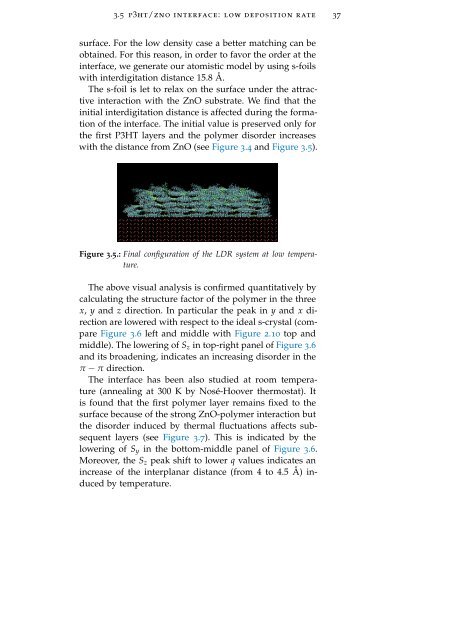Documento PDF - UniCA Eprints - Università degli studi di Cagliari.
Documento PDF - UniCA Eprints - Università degli studi di Cagliari.
Documento PDF - UniCA Eprints - Università degli studi di Cagliari.
Create successful ePaper yourself
Turn your PDF publications into a flip-book with our unique Google optimized e-Paper software.
3.5 p3ht/zno interface: low deposition rate 37surface. For the low density case a better matching can beobtained. For this reason, in order to favor the order at theinterface, we generate our atomistic model by using s-foilswith inter<strong>di</strong>gitation <strong>di</strong>stance 15.8 Å.The s-foil is let to relax on the surface under the attractiveinteraction with the ZnO substrate. We find that theinitial inter<strong>di</strong>gitation <strong>di</strong>stance is affected during the formationof the interface. The initial value is preserved only forthe first P3HT layers and the polymer <strong>di</strong>sorder increaseswith the <strong>di</strong>stance from ZnO (see Figure 3.4 and Figure 3.5).Figure 3.5.: Final configuration of the LDR system at low temperature.The above visual analysis is confirmed quantitatively bycalculating the structure factor of the polymer in the threex, y and z <strong>di</strong>rection. In particular the peak in y and x <strong>di</strong>rectionare lowered with respect to the ideal s-crystal (compareFigure 3.6 left and middle with Figure 2.10 top andmiddle). The lowering of S z in top-right panel of Figure 3.6and its broadening, in<strong>di</strong>cates an increasing <strong>di</strong>sorder in theπ − π <strong>di</strong>rection.The interface has been also <strong>stu<strong>di</strong></strong>ed at room temperature(annealing at 300 K by Nosé-Hoover thermostat). Itis found that the first polymer layer remains fixed to thesurface because of the strong ZnO-polymer interaction butthe <strong>di</strong>sorder induced by thermal fluctuations affects subsequentlayers (see Figure 3.7). This is in<strong>di</strong>cated by thelowering of S y in the bottom-middle panel of Figure 3.6.Moreover, the S z peak shift to lower q values in<strong>di</strong>cates anincrease of the interplanar <strong>di</strong>stance (from 4 to 4.5 Å) inducedby temperature.
















